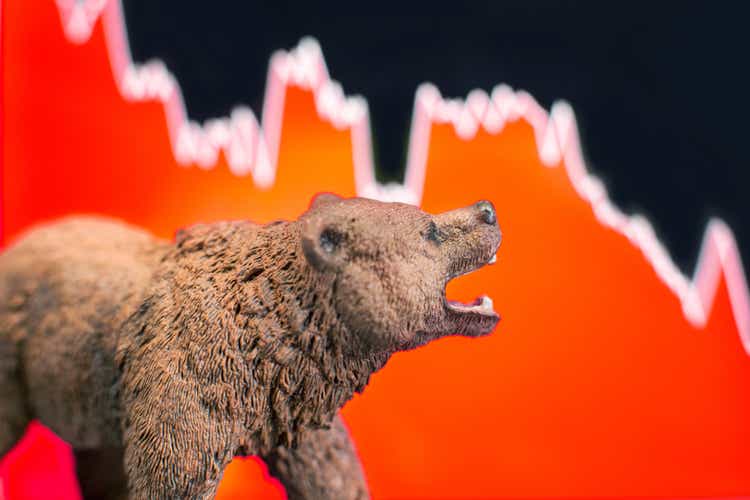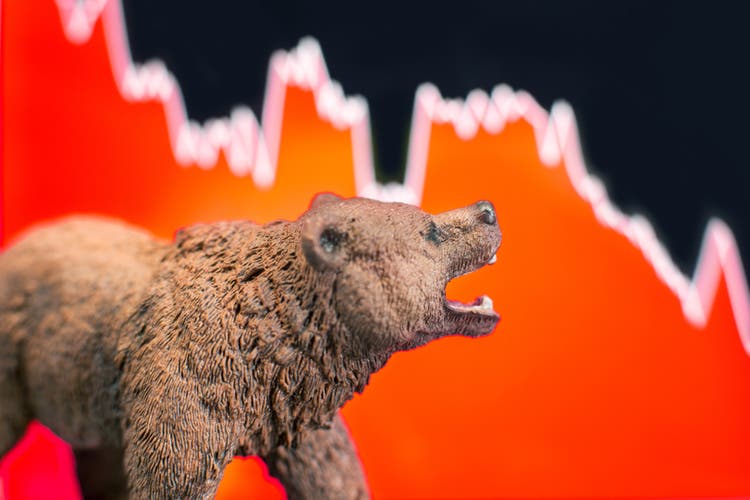[ad_1]
24K-Production/iStock via Getty Images
In many of my recent articles, I have presented research suggesting where investors might consider investing in light of high inflation, rising interest rates, and Federal Reserve policy decisions; for example, see here. In this article, I review what some experts have counseled regarding investments to consider in a bear market.
Background
The overall stock market, as measured by the Vanguard Total Stock Market ETF (VTI), reached its highest price ever on the first trading day of this year. Since then, it is down approximately 17% (all data in this article is as of 5-13). However, some categories of funds have done far worse. For example, according to Morningstar.com, the average Large Cap Growth stock fund is down about 25%.
These drops represent a significant hit to investors’ portfolios. Far beyond what is customarily defined as a 10% correction, a drop of 20% or more from a recent high is considered to be a bear market. Only a scant few fund categories are in positive territory this year, most down anywhere from 10 to 20%. (See this performance data for the latest year-to-date results for Vanguard ETFs; results for Vanguard mutual funds are in the same ballpark.) In a bear market, it no longer seems a matter of expecting to make money with your investments, at least in the short term. Rather, a more realistic strategy becomes trying to lose as little as possible until market conditions improve.
I reviewed what a few top investor publications recommend as your best ETF and fund choices might be during these uncertain and, thus far in 2022, decidedly negative periods for fund investments. Along with listing their specific fund recommendations, I’ve added my some of my own comments, although I am not myself thoroughly familiar with all of these funds.
Kiplinger in The 12 Best ETFs to Battle a Bear Market, offers some of the most specific recommendations I found, although the recommendations were made over two years ago and a few of them are redundant and therefore won’t be mentioned below. Also, I won’t mention funds that are losing more than 10% this year.
The Funds
Legg Mason Low Volatility High Dividend ETF (LVHD)
This fund is made up of mainly Large Value stocks, which my articles have been recommending for quite some time, while low volatility stocks tend not to move as much as higher volatility ones. Since downturns are usually accompanied by high volatility, investors will probably lose less during periods when stocks are going down. Volatility is measured by a statistic called “beta” with the S&P 500 having a beta of 1. A lower beta means the fund has less volatility than this index, while a beta above 1 has more; LVHD has a beta of 0.8 The fund also has a high dividend yield of 3.62%; see below for more information on high dividend yield funds. It is losing only 2.44 year-to-date as compared to the Dow Jones U.S. Large-Cap Value Total Stock Market Index which is losing 10.83. (All performance data shown is not annualized)
Utilities Select Sector SPDR® ETF (XLU)
Everyone needs water and electricity, and in some cases natural gas, regardless of tight economic times. Thus, in theory, utility funds shouldn’t suffer due to lost business like other stocks may. During times when stocks are falling, investors often seek out funds with high dividends, and currently, this fund pays a dividend of 2.82%. The fund is one of the few that are actually up, 0.45 so far this year. Utility funds appear to be among one of the best performers when inflation is high, as it is now. (See my April Seeking Alpha article The Best ETFs To Own When Inflation Is High). Utilities can adjust their prices higher even when the overall economy slips, helping to maintain or improve their profits and dividends.
Consumer Staples Select Sector SPDR® ETF (XLP)
Like utilities, people still need basic consumables such as food and toilet paper regardless of economic conditions. Also, like utilities, these stocks tend to pay an above average dividend, currently at 2.25%. The year-to-date return is currently at +0.24%.
Vanguard Short-Term Bond ETF (BSV)
This ETF invests mainly in government bonds with a smaller share in corporates. Short-term bonds have a low duration which means they are least hurt when interest rates rise as compared to longer term bonds. While the highly popular Vanguard Total Bond Market index ETF (BND) is down 9.71, BSV is down only 4.10% so far this year.
VanEck Vectors Gold Miners ETF (GDX)
Gold is considered by many investors to be a hedge against inflation and something that may retain its value under dire circumstances. However, holding the metal itself provides an investor with no dividends. Instead, GDX holds the companies that mine gold. It currently pays a dividend of 1.73%. Its year-to-date return is -3.59 % based on its market price. This compares to a return of -17.5% for the S&P 500 index.
ProShares Short S&P 500 ETF (SH)
This is a fund I don’t recommend at all for the average investor, only for extremely aggressive investors who are usually market timers as well. The fund is involved in “shorting” the S&P 500 which means it bets against the index and does well only when it goes down instead of up. So, since the S&P 500 is down about 16% this year, it is up the inverse of that or about +15%. Since stocks tend to go up much more than down, you can only make money if you invest right before or in a downturn and get out before stocks resume an upward path. Not for me.
Vanguard High Dividend Yield Index Adm (VYM)
Similar to the first two funds listed above, the advantage of this fund is it pays a high dividend yield of 2.77%. It also has a relatively low beta of 0.86. It is down so far this year about 3% and has a Large Cap Value-oriented portfolio.
Invesco DB Commodity Index Tracking (DBC)
Commodities such as energy, gold, other metals, and raw materials are thought to perform well during periods of high inflation and bear markets. However, they are highly volatile indicating above average risk. DBC is currently providing excellent returns so far in 2022 at about +35% as well as an excellent return over the last 12 months, namely +53.5%.
Vanguard Dividend Growth Inv (VDIGX)
While down 8.20% this year, this mutual fund is ahead of 95% of the funds in its category according to Morningstar and the -16% for the S&P 500. Since the fund was lauded in a May 2020 article as an excellent fund for a down market, it has returned over 43%, a little more than the Vanguard S&P 500 index ETF (VOO). Its focus is on the Large Blend category.
Discussion
While investors are not necessarily advised to switch out of their existing funds to one or more of these bear market stalwarts, perhaps one or two of the above funds, or similar ones, will give them some ideas as to where they might be able to hide out during this currently steep bear market for aggressive funds, or approaching one, for many of their customary funds.
[ad_2]
Source links Google News

